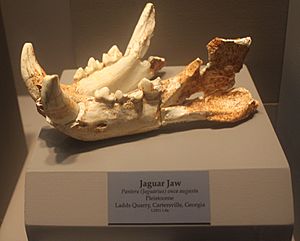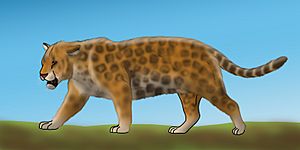Panthera onca augusta facts for kids
Quick facts for kids Panthera onca augusta |
|
|---|---|
 |
|
| Scientific classification |
|
| Kingdom: | Animalia |
| Phylum: | Chordata |
| Class: | Mammalia |
| Order: | Carnivora |
| Suborder: | Feliformia |
| Family: | Felidae |
| Subfamily: | Pantherinae |
| Genus: | Panthera |
| Species: | |
| Subspecies: |
†P. o. augusta
|
| Trinomial name | |
| Panthera onca augusta (Leidy, 1872)
|
|
| Synonyms | |
|
|

Imagine a jaguar, but much bigger! That's what Panthera onca augusta was. It's also known as the Pleistocene jaguar or simply the giant jaguar. This amazing animal was an extinct subspecies of the jaguar. It lived a long, long time ago, during the Pleistocene Ice Age. This means it roamed North America from about 1.8 million to 11,000 years ago. It was found only in North America and is now extinct, meaning it no longer roams the Earth.
Contents
Discovering the Giant Jaguar!
Even though jaguars still live in parts of the southern United States today, the giant jaguar is gone. Scientists first described its fossil remains in 1872. These first fossils were found by Ferdinand Vandeveer Hayden near the Platte River in Nebraska. He sent them to a scientist named Joseph Leidy in Philadelphia. Leidy was the one who first named this new animal Felis augustus.
Early Discoveries
The first fossils found included parts of a jaw and a tooth. At first, Leidy thought these fossils were from an even older time period, but later scientists realized they were from the Pleistocene.
Later, in 1919, another scientist named Oliver Perry Hay found a tooth in Florida. He named it Felis veronis. However, scientists now agree that this tooth also belonged to the giant jaguar, P. onca augusta. More teeth and jawbones were found in Florida in the 1920s. One of these was the first complete lower jaw of this animal ever found!
More Amazing Finds
In 1938, scientists found two more partial skeletons of the giant jaguar in a place called Cumberland Caverns in Maryland. These bones were mixed with those of a puma.
Some of the most exciting discoveries happened in Tennessee. In 1939, footprints and more fossils were found in Craighead Caverns. Then, in 1944, two very well-preserved skeletons were found in Saltpeter Cave. These skeletons included parts of skulls and many other bones. They clearly showed how different the giant jaguar was from other big cats. Many more fossils, including jaws and skull parts, were later found at Craighead Caverns.
Where Did They Live?
Besides Tennessee and Florida, giant jaguar fossils have also been found in Oregon and, famously, at the La Brea Tar Pits in California. Florida has many fossil sites from the Pleistocene, which is why so many giant jaguar remains have been found there. In 2021, a jawbone found in Mexico showed that the giant jaguar's home range stretched even further south!
See also
 In Spanish: Jaguar americano augusta para niños
In Spanish: Jaguar americano augusta para niños
- Pleistocene South American jaguar, P. onca mesembrina
- Panthera gombaszoegensis
- North American jaguar
- South American jaguar


